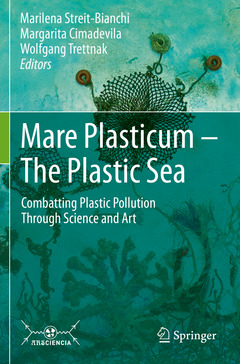Mare Plasticum - The Plastic Sea, 1st ed. 2020 Combatting Plastic Pollution Through Science and Art
Coordonnateurs : Streit-Bianchi Marilena, Cimadevila Margarita, Trettnak Wolfgang

Marilena Streit-Bianchi was born in Rome (Italy). She received a doctorate in Biological Sciences from the University of Rome and joined CERN, the European Organization for Nuclear Research, in Geneva (Switzerland), in 1969. She has been a pioneer in the study of high-energy particles produced by accelerators for cancer treatment. She has held managerial positions in the area of safety training and technology transfer and is currently a senior honorary staff member at CERN, actively engaged in art and science as a book editor and curator of exhibitions in Europe and Mozambique.
Margarita Cimadevila The artist who was born in Sada (A Coruña, Spain), graduated in Chemistry. She then worked as a secondary school science teacher for the Government of Galicia for thirty years, nine of them as director. Her artistic work combines science and art on topics such as the particle physics at CERN, women in science, gender equality and eco art. She is president of the organizationARSCIENCIA and a member of AMIT (Spanish Association of Women Researchers and Technologists). Her work has been exhibited in Europe, America and China.Wolfgang Trettnak was born in Graz (Austria) and received a PhD in Chemistry from the University of Graz. He undertook applied research on sensors and biosensors for several years and published a number of scientific articles. In 2002 he became a freelance artist, and his work, which comprises painting, object art, and installations, has been exhibited in Europe, America, and China. His work links science with art on subjects such as bionics, electronics, luminescence and environmental topics.
Date de parution : 07-2021
Ouvrage de 252 p.
15.5x23.5 cm
Date de parution : 07-2020
Ouvrage de 252 p.
15.5x23.5 cm
Thèmes de Mare Plasticum - The Plastic Sea :
Mots-clés :
marine plastic litter; plastic pollution; microplastic in marine ecosystem; sustainable solutions to plastic pollution; plastic contamination; microplastics in the North Atlantic; marine litter in the Mediterranean Sea; plastic pollution in China and Far East; marine plastic debris; plastic pollution in art and science; public awareness of plastic pollution; eco art and plastic litter; plastic waste; microplastics in soils; plastic ingestion; plastic entanglement; economic impacts of plastic; history of plastics



